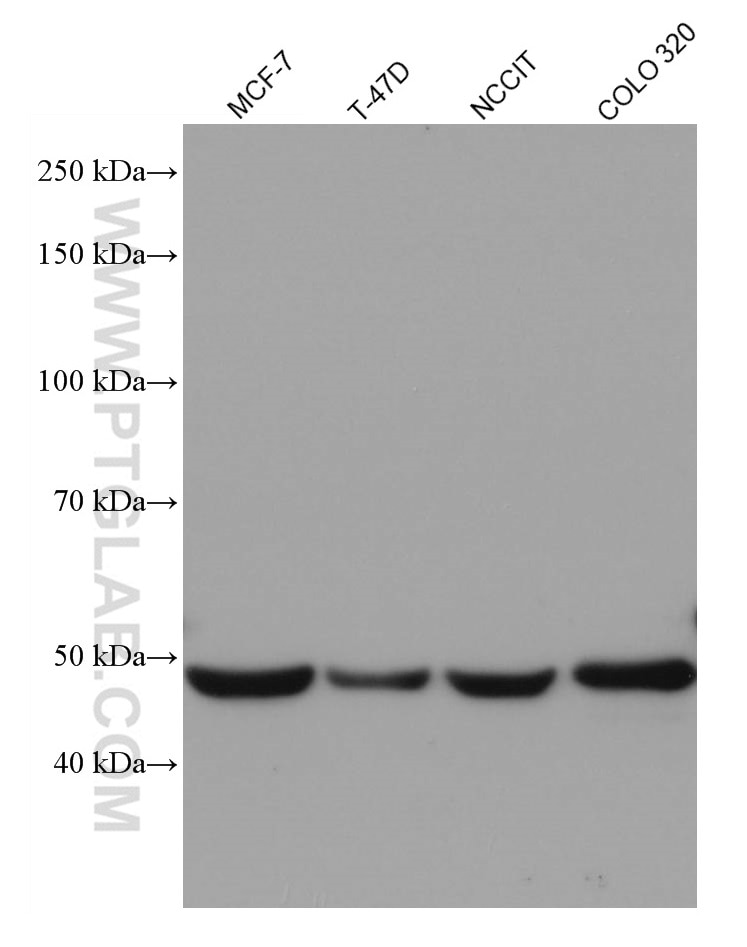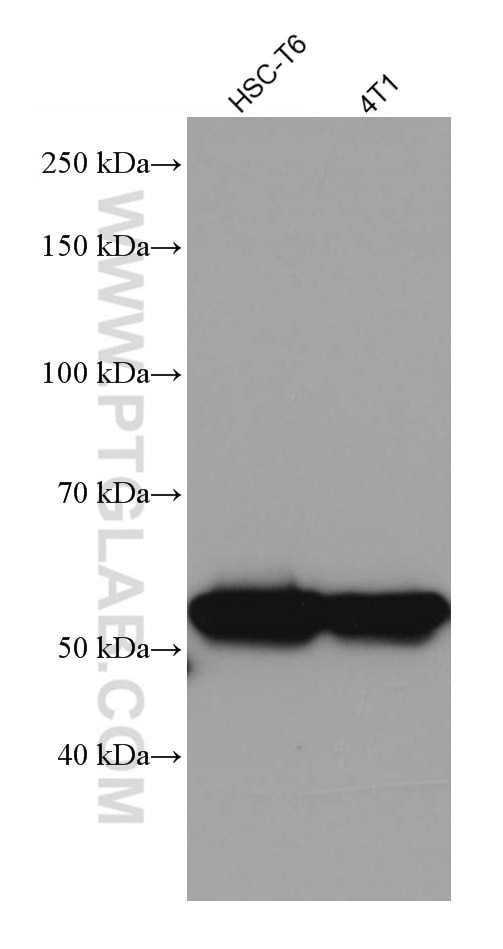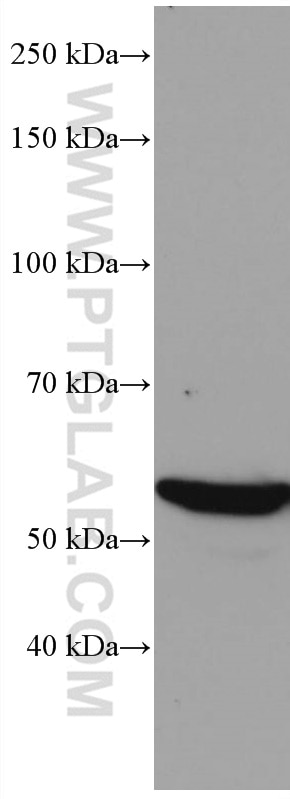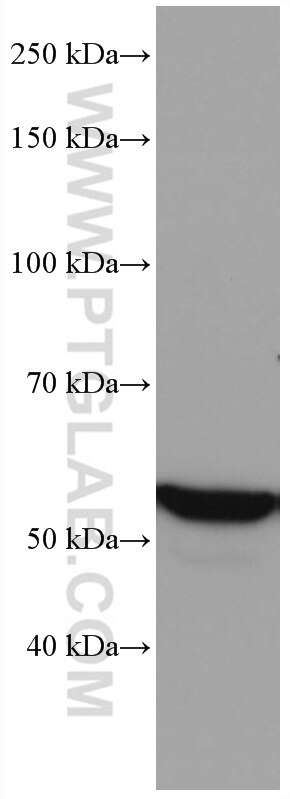- Featured Product
- KD/KO Validated
VDR Monoklonaler Antikörper
VDR Monoklonal Antikörper für WB, ELISA
Wirt / Isotyp
Maus / IgG2a
Getestete Reaktivität
human, Maus, Ratte und mehr (1)
Anwendung
WB, IHC, IF, ChIP, ELISA
Konjugation
Unkonjugiert
CloneNo.
1A9C1
Kat-Nr. : 67192-1-Ig
Synonyme
Geprüfte Anwendungen
| Erfolgreiche Detektion in WB | MCF-7-Zellen, 4T1-Zellen, COLO 320-Zellen, HeLa-Zellen, NCCIT-Zellen, T-47D-Zellen |
Empfohlene Verdünnung
| Anwendung | Verdünnung |
|---|---|
| Western Blot (WB) | WB : 1:2000-1:10000 |
| It is recommended that this reagent should be titrated in each testing system to obtain optimal results. | |
| Sample-dependent, check data in validation data gallery | |
Veröffentlichte Anwendungen
| KD/KO | See 3 publications below |
| WB | See 17 publications below |
| IHC | See 1 publications below |
| IF | See 6 publications below |
| ChIP | See 1 publications below |
Produktinformation
67192-1-Ig bindet in WB, IHC, IF, ChIP, ELISA VDR und zeigt Reaktivität mit human, Maus, Ratten
| Getestete Reaktivität | human, Maus, Ratte |
| In Publikationen genannte Reaktivität | human, Hausschwein, Maus, Ratte |
| Wirt / Isotyp | Maus / IgG2a |
| Klonalität | Monoklonal |
| Typ | Antikörper |
| Immunogen | VDR fusion protein Ag28188 |
| Vollständiger Name | vitamin D (1,25- dihydroxyvitamin D3) receptor |
| Berechnetes Molekulargewicht | 48 kDa |
| Beobachtetes Molekulargewicht | 48-55 kDa |
| GenBank-Zugangsnummer | BC060832 |
| Gene symbol | VDR |
| Gene ID (NCBI) | 7421 |
| Konjugation | Unkonjugiert |
| Form | Liquid |
| Reinigungsmethode | Protein-A-Reinigung |
| Lagerungspuffer | PBS with 0.02% sodium azide and 50% glycerol |
| Lagerungsbedingungen | Bei -20°C lagern. Nach dem Versand ein Jahr lang stabil Aliquotieren ist bei -20oC Lagerung nicht notwendig. 20ul Größen enthalten 0,1% BSA. |
Hintergrundinformationen
The vitamin D receptor (VDR), also known as NR1I1 (nuclear receptor subfamily 1, group I, member 1), is a member of the nuclear receptor family of transcription factors. Upon activation by vitamin D, the VDR forms a heterodimer with the retinoid-X receptor and binds to hormone response elements on DNA resulting in expression or trans-repression of specific gene products.It is an intracellular hormone receptor that specifically binds 1,25(OH)2D3 and mediates its effects. Downstream targets of this nuclear hormone receptor are principally involved in mineral metabolism though the receptor regulates a variety of other metabolic pathways, such as those involved in the immune response and cancer. Defects in VDR are the cause of rickets vitamin D-dependent type 2A (VDDR2A). A disorder of vitamin D metabolism results in severe rickets, hypocalcemia and secondary hyperparathyroidism. Most patients have total alopecia in addition to rickets. The VDR exists two isoform with the MV 48 kDa and 54 kDa.
Protokolle
| PRODUKTSPEZIFISCHE PROTOKOLLE | |
|---|---|
| WB protocol for VDR antibody 67192-1-Ig | Protokoll herunterladen |
| STANDARD-PROTOKOLLE | |
|---|---|
| Klicken Sie hier, um unsere Standardprotokolle anzuzeigen |
Publikationen
| Species | Application | Title |
|---|---|---|
Antioxidants (Basel) Fibroblast Upregulation of Vitamin D Receptor Represents a Self-Protective Response to Limit Fibroblast Proliferation and Activation during Pulmonary Fibrosis | ||
Front Pharmacol Bacteroides dorei BDX-01 alleviates DSS-induced experimental colitis in mice by regulating intestinal bile salt hydrolase activity and the FXR-NLRP3 signaling pathway | ||
Front Cell Dev Biol Single-Cell Transcriptomics Reveals the Molecular Anatomy of Sheep Hair Follicle Heterogeneity and Wool Curvature. | ||
Eur J Pharmacol Vitamin D3 analogue calcipotriol inhibits the profibrotic effects of transforming growth factor- β1 on pancreatic stellate cells | ||
Phytomedicine Asperuloside inhibited epithelial-mesenchymal transition in colitis associated cancer via activation of vitamin D receptor.
| ||
Front Microbiol Vitamin D3 Suppresses Human Cytomegalovirus-Induced Vascular Endothelial Apoptosis via Rectification of Paradoxical m6A Modification of Mitochondrial Calcium Uniporter mRNA, Which Is Regulated by METTL3 and YTHDF3.
|





